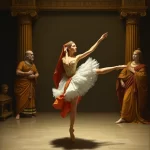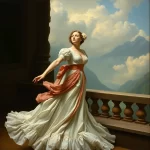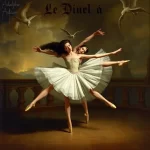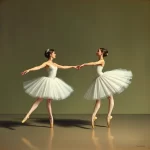Ballet: The Pharaoh’s Daughter (Cesare Pugni, 1862)

Introduction
Ballet, a classical dance form known for its grace and precision, has produced numerous masterpieces over the centuries. One such gem is “The Pharaoh’s Daughter,” a ballet composed by Cesare Pugni and choreographed by Marius Petipa. Premiering on November 18, 1862, at the Imperial Bolshoi Kamenny Theatre in St. Petersburg, this ballet has captivated audiences with its exotic themes and elaborate storytelling. The ballet’s plot revolves around an Englishman who, through a fantastical dream, finds himself in ancient Egypt, where he falls in love with the Pharaoh’s daughter.
Historical Background
Creation and Development
“The Pharaoh’s Daughter” was created during a period of significant cultural and artistic development in Russia. The mid-19th century was a time when Russian ballet was beginning to establish its own identity, distinct from its Western European counterparts. The ballet was inspired by Théophile Gautier’s novel “Le Roman de la Momie,” which provided a rich tapestry of ancient Egyptian culture and mythology for the creators to explore.
The collaboration between Marius Petipa, a French ballet master who had settled in Russia, and Cesare Pugni, an Italian composer, was instrumental in bringing this ballet to life. Petipa’s innovative choreography combined with Pugni’s evocative score created a production that was both visually and musically stunning.
Premiere and Reception
The ballet premiered on November 18, 1862, at the Imperial Bolshoi Kamenny Theatre in St. Petersburg. The initial reception was overwhelmingly positive, with critics and audiences alike praising the ballet’s grandeur and the seamless integration of music and dance. Notable early performances included those by the prima ballerina Carolina Rosati, who played the role of Aspicia, the Pharaoh’s daughter.
Synopsis of the Ballet
Act I Summary
The ballet begins with an Englishman named Lord Wilson and his servant traveling through Egypt. Seeking refuge from a sandstorm, they take shelter in a pyramid. Inside, they encounter a mysterious figure who offers them opium. As Lord Wilson falls asleep, he dreams of being transported back to ancient Egypt, where he becomes Ta-Hor, a young Egyptian nobleman.
In this dream world, Ta-Hor meets Aspicia, the Pharaoh’s daughter, and they fall in love. However, their love is forbidden, and they must navigate various challenges to be together.
Act II Summary
In the second act, Ta-Hor and Aspicia’s love faces numerous obstacles. They are pursued by the Pharaoh’s guards and must escape through a series of adventures. One of the most dramatic moments occurs when Aspicia throws herself into the Nile to avoid capture, only to be saved by the river god.
Act III Summary
The final act sees Ta-Hor and Aspicia reunited, but their happiness is short-lived as they are once again confronted by the Pharaoh. In a climactic scene, Ta-Hor is forced to prove his love and loyalty to Aspicia. Just as it seems all hope is lost, Lord Wilson awakens from his dream, back in the pyramid, with a newfound appreciation for the power of love and destiny.
Finale
The ballet concludes with Lord Wilson reflecting on his dream and the lessons he has learned. The story’s resolution emphasizes the timeless nature of love and the idea that true love can transcend even the boundaries of time and reality.
Musical Composition
Composer’s Role
Cesare Pugni, an Italian composer known for his prolific work in ballet music, played a crucial role in the success of “The Pharaoh’s Daughter.” His score for the ballet is characterized by its rich orchestration and memorable melodies, which perfectly complement Petipa’s choreography. Notable pieces within the score include the grand pas de deux and the evocative music for the river god scene.
Musical Themes and Motifs
Pugni’s score features several recurring musical themes and leitmotifs that enhance the narrative and emotional depth of the ballet. For example, the love theme associated with Ta-Hor and Aspicia recurs throughout the ballet, underscoring their romantic connection. The music also incorporates elements of Egyptian musical styles, adding an exotic flavor to the score.
Famous Recordings and Performances
Over the years, there have been several iconic recordings and performances of “The Pharaoh’s Daughter.” Notable among these is the 2000 revival by the Bolshoi Ballet, which was recorded and released on DVD. This production, featuring Svetlana Zakharova as Aspicia, received widespread acclaim for its faithful recreation of Petipa’s original choreography and Pugni’s score.
Choreography and Dance
Choreographer’s Vision
Marius Petipa’s vision for “The Pharaoh’s Daughter” was to create a ballet that combined dramatic storytelling with innovative choreography. Petipa’s style is characterized by its intricate footwork, expressive mime, and grandiose group scenes. He introduced several innovations in this ballet, including the use of elaborate sets and costumes to create a vivid depiction of ancient Egypt.
Signature Dance Numbers
One of the most memorable dance numbers in “The Pharaoh’s Daughter” is the grand pas de deux between Ta-Hor and Aspicia. This dance showcases the technical prowess and emotional expressiveness of the lead dancers. Another standout moment is the river god scene, where Aspicia’s dramatic leap into the Nile is followed by a mesmerizing underwater ballet sequence.
Notable Interpretations
Over the years, different productions of “The Pharaoh’s Daughter” have offered unique interpretations of Petipa’s choreography. Some have emphasized the ballet’s exotic and fantastical elements, while others have focused on the romantic and dramatic aspects of the story. Notable interpretations include the 2000 Bolshoi Ballet revival and the 2018 production by the Mariinsky Ballet, which featured updated choreography by Pierre Lacotte.
Characters and Roles
Main Characters
- Lord Wilson/Ta-Hor: An Englishman who dreams of being an Egyptian nobleman. He is the ballet’s protagonist and falls in love with Aspicia.
- Aspicia: The Pharaoh’s daughter, who falls in love with Ta-Hor. She is a central figure in the ballet and embodies grace and determination.
- The Pharaoh: Aspicia’s father, who opposes her relationship with Ta-Hor.
Supporting Characters
- Lord Wilson’s Servant: Accompanies Lord Wilson on his journey and provides comic relief.
- The River God: A mystical figure who saves Aspicia from drowning.
- The Mysterious Figure: Offers Lord Wilson opium, leading to his dream.
Famous Dancers
Several renowned dancers have portrayed the lead roles in “The Pharaoh’s Daughter” over the years. Carolina Rosati was the original Aspicia, while more recent interpretations have featured stars like Svetlana Zakharova and Natalia Osipova. These dancers have brought their unique styles and interpretations to the roles, contributing to the ballet’s enduring popularity.
Cultural and Artistic Impact
Influence on Ballet and Dance
“The Pharaoh’s Daughter” has had a significant influence on the development of ballet as an art form. Petipa’s innovative choreography set new standards for storytelling and technical excellence in ballet. The ballet’s success also helped to establish Russian ballet as a major force in the world of dance.
Cultural Significance
The ballet’s exotic themes and dramatic storytelling have made it a popular subject in various forms of media. It has been referenced in literature, film, and theater, and its influence can be seen in other works that explore similar themes of love and adventure in ancient settings.
Legacy and Revivals
“The Pharaoh’s Daughter” continues to be performed and celebrated today, with major revivals by companies like the Bolshoi Ballet and the Mariinsky Ballet. These revivals have introduced the ballet to new generations of audiences and ensured its place in the repertoire of classical ballet.
Iconic Productions
Historic Productions
One of the most famous historical productions of “The Pharaoh’s Daughter” was the original 1862 premiere at the Imperial Bolshoi Kamenny Theatre. This production featured elaborate sets and costumes designed by Andreas Roller and was a major success.
Contemporary Productions
Recent productions of “The Pharaoh’s Daughter” have brought new life to the ballet. The 2000 Bolshoi Ballet revival, directed by Pierre Lacotte, is particularly notable for its faithful recreation of Petipa’s original choreography and its stunning visual design.
Production Design
The set, costume, and lighting design in various productions of “The Pharaoh’s Daughter” have played a crucial role in bringing the story to life. From the opulent palace of the Pharaoh to the mystical underwater scenes, the production design has helped to create a vivid and immersive experience for audiences.
Critical Reception and Reviews
Initial Critical Response
At the time of its premiere, “The Pharaoh’s Daughter” received glowing reviews from critics. They praised the ballet’s innovative choreography, evocative music, and elaborate production design. The performances of the lead dancers, particularly Carolina Rosati as Aspicia, were also highly acclaimed.
Modern Reviews
Contemporary critics continue to appreciate “The Pharaoh’s Daughter” for its historical significance and artistic excellence. Modern productions have been praised for their faithful recreations of Petipa’s choreography and Pugni’s score, as well as for their ability to captivate new audiences with the ballet’s timeless story.
Fun Facts and Trivia
Behind-the-Scenes Stories
One interesting anecdote from the original production involves Carolina Rosati, who was so dedicated to her role as Aspicia that she insisted on performing even when she was ill. Her commitment to the role helped to cement her reputation as one of the greatest ballerinas of her time.
Notable Performers
In addition to Carolina Rosati, other famous dancers who have portrayed roles in “The Pharaoh’s Daughter” include Svetlana Zakharova, Natalia Osipova, and Ivan Vasiliev. These dancers have brought their unique styles and interpretations to the ballet, contributing to its enduring popularity.
Trivia
- “The Pharaoh’s Daughter” was one of the first ballets to incorporate elements of Egyptian culture and mythology into its story and design.
- The ballet’s original sets and costumes were designed by Andreas Roller, a renowned stage designer of the time.
- The 2000 Bolshoi Ballet revival was directed by Pierre Lacotte, who meticulously researched Petipa’s original choreography to create an authentic production.
Conclusion
Summary of the Ballet’s Importance
“The Pharaoh’s Daughter” is a significant work in the world of ballet for its innovative choreography, evocative music, and dramatic storytelling. It has influenced generations of dancers and choreographers and continues to be celebrated for its artistic excellence.
Final Thoughts
Reflecting on “The Pharaoh’s Daughter,” it is clear that this ballet has left an indelible mark on the world of dance. Its timeless themes of love and adventure, combined with its rich cultural and historical context, make it a must-see for ballet enthusiasts. Whether you are watching a live performance or listening to a recording of Pugni’s score, “The Pharaoh’s Daughter” offers a captivating and unforgettable experience.
FAQ
What is the central theme of this ballet?
The central theme of “The Pharaoh’s Daughter” is the power of love and destiny, as explored through the fantastical dream of an Englishman who finds himself in ancient Egypt.
Who are the main characters in this ballet?
The main characters are Lord Wilson/Ta-Hor, an Englishman who dreams of being an Egyptian nobleman, and Aspicia, the Pharaoh’s daughter who falls in love with him.
What is the most famous dance number in this ballet?
The grand pas de deux between Ta-Hor and Aspicia is one of the most famous dance numbers in “The Pharaoh’s Daughter,” showcasing the technical prowess and emotional expressiveness of the lead dancers.
How long does a typical performance of this ballet last?
A typical performance of “The Pharaoh’s Daughter” lasts approximately two to three hours, including intermissions.
Are there any modern adaptations of this ballet?
Yes, there have been several modern adaptations and revivals of “The Pharaoh’s Daughter,” including notable productions by the Bolshoi Ballet and the Mariinsky Ballet.
Why is this ballet considered important in the history of dance?
“The Pharaoh’s Daughter” is considered important in the history of dance for its innovative choreography by Marius Petipa, its evocative score by Cesare Pugni, and its influence on the development of Russian ballet as a major force in the world of dance.





